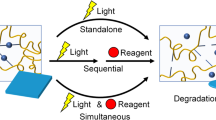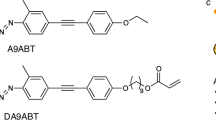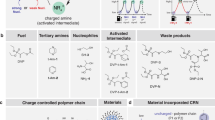Abstract
Crosslinked liquid-crystalline polymers (CLCPs) show macroscopic deformation along with a change in molecular order, which is triggered by various stimuli such as heat, electricity, and light. CLCPs containing photochromic moieties are realizable as photoresponsive soft actuators. This review focuses on recent developments in novel network structures of CLCPs: rearrangeable networks and interpenetrating polymer networks (IPNs). CLCPs with dynamic covalent bonds could be reshaped into 3D architectures through the rearrangement of the network topology, in contrast with conventional crosslinked polymers memorizing permanent shapes. The reshaped samples showed various photoinduced motions depending on their initial shapes. Furthermore, amorphous polymers were incorporated into conventional CLCP networks to control mechanical and photoresponsive properties. The sequential formation of CLCP and amorphous polymer networks resulted in IPN films with a homogeneous alignment of mesogens. The elastic moduli of IPN films were controlled through the selection of amorphous components. The incorporation of soft components such as poly(dodecyl methacrylate) and poly(dimethylsiloxane) (PDMS) significantly enhanced the rate of photoinduced bending. These strategies of controlling the network structures of CLCPs could enable the versatile design of photomobile polymer materials as soft actuators with desired architectures and functions.
Similar content being viewed by others
Log in or create a free account to read this content
Gain free access to this article, as well as selected content from this journal and more on nature.com
or
References
Warner M, Terentjev EM. Liquid crystal elastomers. Oxford: Oxford University Press; 2003.
Ohm C, Brehmer M, Zentel R. Liquid crystalline elastomers as actuators and sensors. Adv Mater. 2010;22:3366–87.
White TJ, Broer DJ. Programmable and adaptive mechanics with liquid crystal polymer networks and elastomers. Nat Mater. 2015;14:1087–98.
Ikeda T, Mamiya J, Yu Y. Photomechanics of liquid-crystalline elastomers and other polymers. Angew Chem Int Ed. 2007;46:506–28.
Yamada M, Kondo M, Mamiya J, Yu Y, Kinoshita M, Barrett CJ, et al. Photomobile polymer materials: towards light-driven plastic motors. Angew Chem Int Ed. 2008;47:4986–8.
Ikeda T, Ube T. Photomobile polymer materials: from nano to macro. Mater Today. 2011;14:480–7.
Ube T, Ikeda T. Photomobile polymer materials with crosslinked liquid-crystalline structures: molecular design, fabrication, and functions. Angew Chem Int Ed. 2014;53:10290–9.
Rich SI, Wood RJ, Majidi C. Untethered soft robotics. Nat Electron. 2018;1:102–12.
de Gennes PG. Reflexions sur un type de polymeres nematiques. C R Acad Sci B. 1975;281:101–3.
Finkelmann H, Kock H, Rehage G. Investigations on liquid-crystalline polysiloxanes. 3. liquid-crystalline elastomers—a new type of liquid-crystalline material. Makromol Chem Rapid Commun. 1981;2:317–22.
Finkelmann H, Kock HJ, Gleim W, Rehage G. Investigations on liquid crystalline polysiloxanes, 5. Orientation of LC-elastomers by mechanical forces. Makromol Chem Rapid Commun. 1984;5:287–93.
Küpfer J, Finkelmann H. Nematic liquid single-crystal elastomers. Makromol Chem Rapid Commun. 1991;12:717–26.
Wermter H, Finkelmann H. Liquid crystalline elastomers as artificial muscles. e-Polym. 2001;1:111–23.
Roberts PMS, Mitchell GR, Davis FJ. A single director switching mode for monodomain liquid crystal elastomers. J Phys II. 1997;7:1337–51.
Thomsen DL, Keller P, Naciri J, Pink R, Jeon H, Shenoy D, et al. Liquid crystal elastomers with mechanical properties of a muscle. Macromolecules. 2001;34:5868–75.
Li MH, Keller P, Li B, Wang X, Brunet M. Light-driven side-on nematic elastomer actuators. Adv Mater. 2003;15:569–72.
Broer DJ, Finkelmann H, Kondo K. In-situ photopolymerization of an oriented liquid-crystalline acrylate. Makromol Chem. 1988;189:185–94.
Tazuke S, Kurihara S, Ikeda T. Amplified image recording in liquid-crystal media by means of photochemically triggered phase-transition. Chem Lett. 1987;16:911–4.
Ikeda T. Photomodulation of liquid crystal orientations for photonic applications. J Mater Chem. 2003;13:2037–57.
Finkelmann H, Nishikawa E, Pereira GG, Warner M. A new opto-mechanical effect in solids. Phys Rev Lett. 2001;87:015501.
Yu Y, Nakano M, Ikeda T. Directed bending of a polymer film by light. Nature. 2003;425:145.
Ikeda T, Nakano M, Yu Y, Tsutsumi O, Kanazawa A. Anisotropic bending and unbending behavior of azobenzene liquid-crystalline gels by light exposure. Adv Mater. 2003;15:201–5.
Denissen W, Winne JM, Du Prez FE. Vitrimers: permanent organic networks with glass-like fluidity. Chem Sci. 2015;7:30–8.
Montarnal D, Capelot M, Tournilhac F, Leibler L. Silica-like malleable materials from permanent organic networks. Science. 2011;334:965–8.
Capelot M, Montarnal D, Tournilhac F, Leibler L. Metal-catalyzed transesterification for healing and assembling of thermosets. J Am Chem Soc. 2012;134:7664–7.
Pei Z, Yang Y, Chen Q, Terentjev EM, Wei Y, Ji Y. Mouldable liquid-crystalline elastomer actuators with exchangeable covalent bonds. Nat Mater. 2014;13:36–41.
Ube T, Kawasaki K, Ikeda T. Photomobile Liquid-crystalline elastomers with rearrangeable networks. Adv Mater. 2016;28:8212–7.
Yamada Y, Kondo M, Miyasato R, Naka Y, Mamiya J, Kinoshita M, et al. Photomobile polymer materials—various three-dimensional movements. J Mater Chem. 2009;19:60–2.
Wang W, Sun X, Wu W, Peng H, Yu Y. Photoinduced deformation of crosslinked liquid-crystalline polymer film oriented by a highly aligned carbon nanotube sheet. Angew Chem Int Ed. 2012;51:4644–7.
Gong JP, Katsuyama Y, Kurokawa T, Osada Y. Double-network hydrogels with extremely high mechanical strength. Adv Mater. 2003;15:1155–8.
Gong JP. Why are double network hydrogels so tough? Soft Matter. 2010;6:2583–90.
Ha SM, Yuan W, Pei QB, Pelrine R, Stanford S. Interpenetrating polymer networks for high-performance electroelastomer artificial muscles. Adv Mater. 2006;18:887–91.
Ube T, Takado K, Ikeda T. Photomobile materials with interpenetrating polymer networks composed of liquid-crystalline and amorphous polymers. J Mater Chem C. 2015;3:8006–9.
Ube T, Minagawa K, Ikeda T. Interpenetrating polymer networks of liquid-crystalline azobenzene polymers and poly(dimethylsiloxane) as photomobile materials. Soft Matter. 2017;13:5820–3.
Acknowledgements
The author thanks Prof. Tomiki Ikeda for collaboration and discussion. The author acknowledges the experimental support provided by the students at Chuo University, especially Kiyohide Takado, Kyohei Kawasaki, and Ken Minagawa. This work was supported by JSPS KAKENHI Grant Numbers JP26870592, JP15K13712, JP15H01095, JP16H04157, JP17H05271, JP17K19161, JP18H04524, and JP18K14286.
Author information
Authors and Affiliations
Corresponding author
Ethics declarations
Conflict of interest
The author declares no conflict of interest.
Additional information
Publisher’s note: Springer Nature remains neutral with regard to jurisdictional claims in published maps and institutional affiliations.
Rights and permissions
About this article
Cite this article
Ube, T. Development of novel network structures in crosslinked liquid-crystalline polymers. Polym J 51, 983–988 (2019). https://doi.org/10.1038/s41428-019-0224-1
Received:
Revised:
Accepted:
Published:
Issue date:
DOI: https://doi.org/10.1038/s41428-019-0224-1
This article is cited by
-
Light- and humidity-driven fluorescence changeable soft robot enabled by water-gated photoinduced electron transfer pathway
Science China Materials (2023)
-
Photomechanical materials driven by photoisomerization or photodimerization
Polymer Journal (2020)



